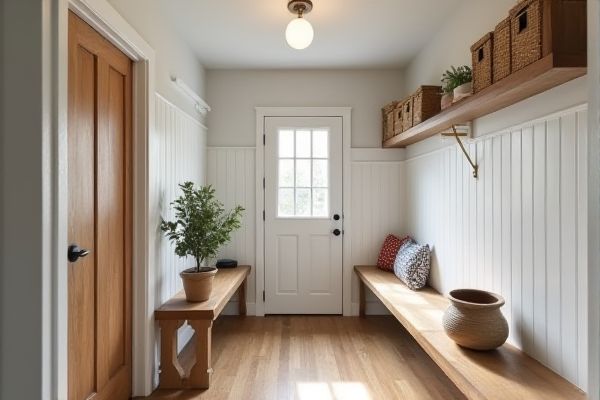
Mudroom laminate offers superior water resistance and durability against dirt and moisture, making it ideal for high-traffic entryways, while engineered wood provides a more authentic hardwood appearance with moderate moisture resistance. Discover which flooring option best suits Your mudroom's needs by exploring the detailed comparison in the rest of the article.
Table of Comparison
| Feature | Mudroom Laminate | Engineered Wood |
|---|---|---|
| Durability | Highly resistant to scratches and moisture | Moderately durable, better than solid wood but sensitive to moisture |
| Moisture Resistance | Excellent, ideal for mudrooms prone to water and dirt | Good with proper sealing, but can warp if exposed to excess water |
| Installation | Easy, often click-lock system for DIY-friendly setup | Requires professional installation, more complex than laminate |
| Appearance | Variety of wood-look styles, less natural grain | Authentic wood grain, richer texture and finish |
| Cost | Lower cost, budget-friendly | Higher cost due to real wood layers |
| Maintenance | Low maintenance, easy cleaning with mild detergent | Requires periodic polishing and careful cleaning |
| Lifespan | 10-20 years with proper care | 20-40 years, can be refinished multiple times |
Introduction to Mudroom Flooring Options
Mudroom flooring options commonly include laminate and engineered wood, each offering distinct advantages in durability and water resistance. Laminate flooring features a synthetic top layer designed to withstand moisture and heavy foot traffic, making it ideal for high-use mudrooms. Engineered wood combines real wood veneers with plywood backing, providing both the aesthetic appeal of hardwood and enhanced stability against humidity fluctuations.
Overview: Laminate vs Engineered Wood Flooring
Laminate flooring in mudrooms offers a durable, moisture-resistant surface with a synthetic wear layer that resists scratches and stains, making it ideal for high-traffic, wet environments. Engineered wood features real hardwood layers over plywood, delivering a more authentic wood appearance and the ability to refinish once or twice, but it is less water-resistant than laminate. Choosing between these options depends on priorities like water resistance, aesthetic appeal, and maintenance requirements for the mudroom space.
Durability in High-Traffic Mudroom Areas
Laminate flooring offers high durability in high-traffic mudroom areas due to its scratch-resistant and water-resistant properties, making it ideal for mudrooms exposed to dirt and moisture. Engineered wood provides a strong surface with a hardwood veneer that withstands wear better than solid wood, yet it requires more maintenance to prevent water damage. Your choice depends on the balance between durability needs and the desire for a natural wood appearance in your mudroom.
Water and Moisture Resistance Comparison
Mudroom laminate flooring offers superior water and moisture resistance due to its high-density fiberboard core and waterproof wear layer, making it ideal for spaces prone to spills and humidity. Engineered wood, while more stable than solid wood, has a veneer top layer that can be susceptible to warping or swelling if exposed to excessive moisture over time. Choosing laminate for your mudroom ensures better protection against water damage, maintaining durability and appearance in damp conditions.
Maintenance and Cleaning Requirements
Mudroom laminate flooring offers low maintenance with simple sweeping and occasional damp mopping, resisting stains and moisture effectively. Engineered wood requires more careful cleaning using manufacturer-recommended products to prevent damage, as excessive water and harsh chemicals can degrade its finish. Both options benefit from prompt spill cleanup, but laminate provides a more durable, hassle-free solution for high-traffic, moisture-prone mudroom environments.
Installation Process and Flexibility
Mudroom laminate offers a straightforward installation process with click-lock systems that are ideal for DIY projects, providing flexibility in placement over various subfloors without the need for adhesives. Engineered wood requires more precise installation, often involving gluing or floating methods, and may need acclimation to the environment to prevent warping. Your choice depends on installation skill level and desired adaptability to moisture and temperature fluctuations typically found in mudrooms.
Cost Analysis: Laminate vs Engineered Wood
Laminate flooring in mudrooms offers a cost-effective solution, typically priced between $1 to $3 per square foot, making it significantly more affordable than engineered wood, which ranges from $4 to $10 per square foot. Laminate's lower installation and maintenance expenses further reduce total ownership costs, whereas engineered wood demands higher upfront investment but provides enhanced durability and aesthetic appeal. Evaluating long-term value involves balancing the initial cost savings of laminate with the potential longevity and resale value benefits of engineered wood.
Style, Texture, and Design Variety
Mudroom laminate flooring offers a diverse range of styles and textures that mimic natural wood, stone, or tile with high durability and water resistance, making it ideal for high-traffic, moisture-prone areas. Engineered wood provides authentic wood grain textures and a warm, natural aesthetic, available in various species, finishes, and plank sizes, enhancing design flexibility for cohesive interior styles. Both materials cater to different design priorities: laminate excels in versatility and maintenance, while engineered wood delivers superior realism and refined character.
Eco-Friendliness and Sustainability
Mudroom laminate flooring offers enhanced eco-friendliness by utilizing recycled materials and low-VOC adhesives, reducing environmental impact compared to traditional flooring. Engineered wood combines real wood veneers with plywood cores sourced from sustainably managed forests, promoting responsible forestry and durability. Your choice between these options should consider the balance between renewable resources and recycled content to align with sustainable home design goals.
Final Recommendation: Best Choice for Mudrooms
Engineered wood offers superior moisture resistance and durability, making it an ideal choice for mudrooms where exposure to dirt and water is frequent. Mudroom laminate provides a budget-friendly option with easy maintenance but may lack the long-term resilience of engineered wood. For your mudroom, engineered wood delivers the best balance of strength, aesthetics, and longevity.
 homyna.com
homyna.com